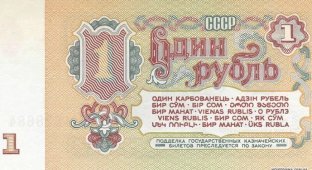Milk in the Soviet Union was made from milk. There was sour cream in the sour cream, kefir in the kefir, and butter in the butter. And the milk also turned sour. In 1-2 days. And it turned out to be yogurt. My mother used this yogurt to cook amazing pancakes...

Every schoolchild went for milk. After school, we very often went shortly before the end of the lunch break to the grocery store or the Milk store. There, they stood among other schoolchildren, young mothers with strollers and pensioners, waiting for a fat saleswoman in a white coat to open the doors of the store. Then everyone rushed to the departments.

In our city, during the lunch break, grocery stores usually brought fresh milk, bread and some other products. Therefore, when the store opened after the lunch break, it was often possible to buy everything specified by the parents. Moreover, it’s fresh.
This was more than relevant for milk and dairy products. After all, that milk actually turned sour very quickly - within a day. And if it had been standing in the store for half a day or a day before, there was a high probability that it would go sour by the morning, or even by the evening.

I still remember those delis. With several departments. Each department sold its own product groups. Many stores were equipped with universal cash registers. In them you had to stand in line and pay for the goods, naming the department, the product and the price for it - for example - milk, a half-liter bottle of milk and a jar of sour cream - 65 kopecks.
The cashier was knocking out a receipt on a huge triangular-shaped cash register, which had to be handed over to the saleswoman in the department. To do this, you had to stand in a queue of the same people with checks. It was worse if the department sold goods by weight. After all, first you had to stand in line - small or large. There they wrote out the weight and price for you on a piece of paper.

Then it’s time to go to the cash register again to get a check, and then again to line up at the department. Smaller stores did not have such a system, and everyone there simply stood in line at the department. There were also self-service supermarkets - similar to today's “markets”. There, goods were paid for at the checkout when leaving the hall.
By the way, dairy products were often stored in dairy departments and stores in metal mesh boxes. Empty containers were then placed in them at glass collection points. When a milk truck was driving down the street, the rattling of these boxes in it could be heard from afar

Basically, all liquid dairy products in the USSR were packaged in glass containers, which were then washed and handed over at special collection points for glass containers or directly at the dairy store. A half-liter milk bottle cost 15 kopecks, a liter bottle cost 20 kopecks, and a jar of sour cream cost 10 kopecks.
The price of the bottle was necessarily included in the price of milk or kefir. In the photo there are samples of milk containers: on the left and right - 0.5-liter bottles, in the center - a liter milk bottle. On the right bottle there is a plastic cap that could be bought at a hardware store for closing milk bottles

There were no labels on the bottles. The label was on the lid. Such bottles were closed with caps made of soft foil of different colors. The name of the product, date of manufacture, and cost were written on the lid. In order to open the bottle, it was enough to simply press the cap with your thumb - it easily sunk a little inside and the cap was removed.
Silver cap - milk (28 kopecks for 0.5 liters, 46 kopecks for 1 liter); dark yellow - baked milk (30 kopecks); green (or turquoise) - kefir (28 kopecks); silver-light green striped - low-fat kefir; blue (or purple) - acidophilus; purple (or pink) - fermented baked milk (29 kopecks); silver with a yellow stripe - sour cream (35 kopecks); pink - sweet kefir drink “Snowball”; yellow-silver striped for cream; blue for honey kefir drink “Kolomensky”; light brown for chocolate milk

In addition to bottles, milk was sold in triangular bags with a capacity of half a liter. Their peculiarity was that they were brought to the sales floor in large aluminum pallets or plastic boxes, and when there were few packages left in the pallet, it was clear that the pallet was covered in milk. The fact is that these bags had a stubborn tendency to leak in the corners. But it was convenient to place them, and convenient to drink directly from the bags, cutting off a corner

Already at the very end of the Soviet era, dairy packaging began its transformation. First, liter bottles disappeared. A year or two later, liter tetra-packs began to appear instead of the traditional half-liter milk bottles. The packages were not thrown away. They were washed, cut off at the top, and used for whatever purpose - for storing bulk items, for growing seedlings in early spring on window sills...

Sour cream was sold in 200 ml jars, all under the same foil cap, or poured from large metal cans, poured into the jar you brought with a large ladle

A special product was butter. When I was a child, there was almost always a line behind him. Especially when they brought butter packaged in the usual packs. There were several types of butter - butter and sandwich.
The sandwich had a lower fat content. But in terms of its composition, it was much better than today's spreads offered to us under the guise of butter. Loose butter cost 3 rubles 40 kopecks per kilogram, and a pack of butter cost 72 kopecks

Another iconic dairy product in the USSR was condensed milk. Children's favorite treat. They drank it straight from the can, punching two holes with a can opener. It was added to coffee. It was boiled directly in a closed jar to be eaten boiled or used for cake. It was the most valuable currency in the pioneer camp

There was also concentrated milk. Theoretically, it had to be diluted, but it was a special relish to drink it undiluted, punching two holes with a knife

At that time milk was also sold from barrels. Apart from the color and inscription, milk barrels were no different from barrels of kvass or beer. And the queue for them was shorter than for beer


Well, how can we not remember the children’s favorite treat – milkshake. In my city, the best milkshakes were made in the Donuts cafe near the Oktyabr children's cinema. And after the show the cafe was always filled with children.

They also made the most delicious ice cream from milk.


Milk and dairy products occupied a fairly significant place in the diet of Soviet people. Porridge was cooked in milk. Noodles and horns were cooked with milk. They simply drank milk from a glass, like we drink juices today. They also drank kefir, fermented baked milk, acidophilus...
For breakfast, my mother often served cottage cheese with tea. Cottage cheese was used to make casseroles and cheesecakes, curd babka and dumplings with cottage cheese. I don’t remember yoghurts or their like. But we ate sour cream from a jar with a teaspoon. It was very tasty. And for dessert there were kefir drinks and children's cheese for 10 kopecks. It was small and incredibly tasty







)))























